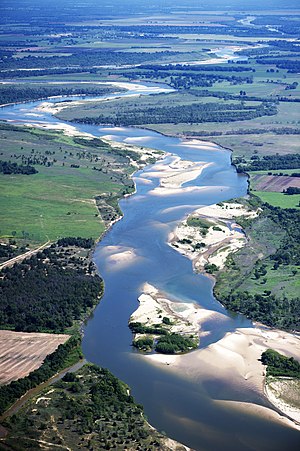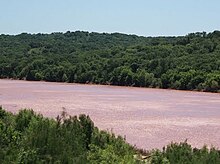Red River of the South
| Red River Rivière Rouge (former French name), Río Colorado (former Spanish name) | |
|---|---|
 Red River looking east, north of Bonham, Texas:
Texas is to the right, Oklahoma is on the left, and the border between the two states runs along the south (right) bank of the river. | |
 Map of the Red River watershed | |
| Native name | Bah'hatteno (Caddo)[1] |
| Location | |
| Country | United States |
| States | Texas, Oklahoma, Arkansas and Louisiana |
| Physical characteristics | |
| Source | |
| • location | Confluence of the Prairie Dog Town Fork and Buck Creek, Harmon County, Oklahoma[2] |
| • coordinates | 34°34′35″N 99°57′54″W / 34.57639°N 99.96500°W |
| • elevation | 1,535 ft (468 m)[citation needed] |
| Mouth | |
• location | Atchafalaya River |
• coordinates | 31°01′10″N 91°44′52″W / 31.01944°N 91.74778°W |
• elevation | 30 ft (9.1 m) |
| Length | 1,360 mi (2,190 km) |
| Basin size | 65,595 sq mi (169,890 km2) |
| Discharge | |
| • location | mouth; max and min at Alexandria, LA |
| • average | 57,000 cu ft/s (1,600 m3/s) |
| • minimum | 1,472 cu ft/s (41.7 m3/s) |
| • maximum | 233,000 cu ft/s (6,600 m3/s) |
The Red River, or sometimes the Red River of the South to differentiate it from the Red River in the north of the continent, is a major river in the Southern United States.[3] It was named for its reddish water color from passing through red-bed country in its watershed.[4] It is known as the Red River of the South to distinguish it from the Red River of the North, which flows between Minnesota and North Dakota into the Canadian province of Manitoba. Although once a tributary of the Mississippi River, the Red River is now a tributary of the Atchafalaya River, a distributary of the Mississippi that flows separately into the Gulf of Mexico. This confluence is connected to the Mississippi River by the Old River Control Structure.
The south bank of the Red River formed part of the
The Red River is the second-largest river basin in the southern
Geography
This section needs additional citations for verification. (January 2022) |
Course
The Red River begins at the junction of Buck Creek and Prairie Dog Town Fork, in Harmon County, Oklahoma.[6][2][note 1]
Specialists have debated whether the
The southern fork is generally considered the main stem of the Red River and about 120 miles (190 km) long. It is formed in


The combined river proceeds to follow a winding course east through one of the most arid parts of the Great Plains, receiving the Wichita River about 25 miles northeast of the city of Wichita Falls. Near Denison, the river exits the eastern end of Lake Texoma, a reservoir formed by the Denison Dam. The lake is also fed by the Washita River from the north. Beyond the dam it runs generally east towards Arkansas and receives Oklahoma's Muddy Boggy Creek on the left bank before turning southward near Texarkana.[citation needed]
Soon after, the waterway crosses south into
Tributaries
Tributaries include the
Saltwater river

The Red River is salty through tributaries above Lake Texoma. The saltiness is caused by a natural phenomenon that dates back to ancient times. About 250 million years ago, an inland sea blanketed parts of what is now those states. As time passed, that sea evaporated, leaving salt deposits – mostly sodium chloride. Rock and silt eventually buried the deposits, but the salt continues to leach through natural seeps in tributaries above Lake Texoma, sending as much as 3,450 tons of salt per day flowing down the Red River.[8][9]
Watershed
The Red River's watershed covers 65,590 square miles (169,900 km2)
History
Native Americans
Native American cultures along the river were diverse, developing specialized adaptations to the many different environments.
American exploration and settlement, 1806 onwards


In 1806, President
In 1806, Lieutenant
In April 1815, Captain Henry Miller Shreve was the first person to bring a steamboat, the Enterprise, up the Red River. Fulton and Livingston, who claimed the exclusive right to navigate Louisiana waters by steamboat, sued Shreve in the District Court of New Orleans. The judge ruled that the monopoly claimed by the plaintiffs was illegal. That decision, along with a similar outcome in Gibbons v. Ogden, freed navigation on every river, lake or harbor in the United States from interference by monopolies.[12]
When
The
In Louisiana, the area of present-day
The area along the lower Red River of Grant Parish, Louisiana and neighboring parishes had a mixture of hill-country farms and cotton plantations.
Great Raft

In the early 19th century, settlers found that much of the river's length in Louisiana was unnavigable because of a collection of fallen trees that formed a Great Raft over 160 miles (260 km) long. In 1839, Captain Henry Miller Shreve began clearing the log jam, but it was not completely cleared until the 1870s, when dynamite became available. The river was thereafter navigable, but north of Natchitoches it was restricted to small craft. Removal of the raft further connected the Red and Atchafalaya rivers, accelerating the development of the Atchafalaya River channel.[7]
"Toll Bridge War"
The Red River Bridge War of 1931 was a boundary conflict between Oklahoma and Texas over an existing toll bridge and a new free bridge crossing the Red River. A joint project to build a free bridge between Durant, Oklahoma and Denison, Texas turned into a major dispute when the Governor of Texas blocked traffic from entering his state on the new bridge. The Red River Bridge Company of Texas owned the original toll bridge and had a dispute over its purchase deal. Oklahoma Governor William H. Murray sent the Oklahoma National Guard to reopen the bridge that July. Texas had to retreat when lawyers determined that Oklahoma had jurisdiction over both banks of the river. [13]
2015 Red River flood
In June 2015, the Red River flooded parts of northeast Texas, southwest Arkansas, southeast Oklahoma and Louisiana, from Denison Dam, to just south of Alexandria, Louisiana.[14]


Recreation
In 1943, Denison Dam was built on the Red River to form
See also
- List of Arkansas rivers
- List of longest main-stem rivers in the United States
- List of Louisiana rivers
- List of Oklahoma rivers
- List of Texas rivers
- Great Raft
- Adams–Onís Treaty
- Red River Campaign, 1864, during the American Civil War, 1861–1865
- Red River War
- Red River Bridge War
- Isle Brevelle
- Smokehouse Creek Fire
- Cane River
- North Fork Red River
- Bayou Brevelle
- Prairie Dog Town Fork Red River
- Cane River National Heritage Area
- Little Red River (Texas)
- Red River Rivalry
- Adai Caddo Indians of Louisiana
Notes
References
- ^ Caddo name. Meredith, Howard. "Caddo (Kadohadacho)." Archived 2010-07-19 at the Wayback Machine Oklahoma Historical Society's Encyclopedia of Oklahoma History and Culture. Retrieved 9 Sept 2012)
- ^ a b "Red River", Feature Details for ID 558278. 31 Dec 1981. https://edits.nationalmap.gov/apps/gaz-domestic/public/gaz-record/558728
- ISBN 0-8061-1659-5
- ^ "Red River Basin". Texas Water Development Board. Retrieved 5 Dec 2020.
- ^ ISBN 9780120882533.
- ^ U.S. Geological Survey, 1985, USGS 1:24000-scale Quadrangle for Hollis SW, OK 1985: U.S. Geological Survey. https://www.sciencebase.gov/catalog/item/5a8a481ee4b00f54eb3fad49
- ^ ISBN 978-1-62349-039-3.
- ^ Malewitz, Jim (21 November 2013). "Communities Along Red River Seek Feds' Help". The Texas Tribune. Retrieved 20 May 2019.
- ^ "U.S. Geological Survey Fact Sheet 170-97". USGS. 1997. Retrieved 20 May 2019.
- ^ Jefferson to Dunbar, 25 May 1805, quoted in T. Lindsay Baker, ed., The Texas Red River country: the official surveys of the headwaters, 1876, 1998: "Foreword", v, and in D.L. Flores, "The Ecology of the Red River in 1806: Peter Custis and Early", The Southwestern Historical Quarterly 88,.1, (July 1984).
- ^ R.B. Marcy, Exploration of the Red River of Louisiana: in the year 1852... with Reports on the Natural History of the Country, Washington, 1853.
- ^ a b Harbour, Emma Estill. "A Brief History of the Red River County since 1803", Chronicles of Oklahoma. Vol. 16. No. 1. March 1938. Archived 2006-12-08 at the Wayback Machine Retrieved September 7, 2013.
- ^ Rusty Williams, The Red River Bridge War: A Texas-Oklahoma Border Battle (Texas A&M University Press, 2016).
- ^ Fuller, Bill (June 11, 2015). "With homes underwater in Louisiana, recovery teams head out". MSN. AP. Retrieved 20 May 2019.
- ^ "Red River of the South". Bridgehunter.com. Retrieved 2017-01-07.
External links
Red River of the South.
- Randolph Marcy, Exploration of the Red River, 1852, hosted by the Portal to Texas History
- Red River from the Handbook of Texas Online
- U.S. Geological Survey Geographic Names Information System: Red River
- Oklahoma Digital Maps: Digital Collections of Oklahoma and Indian Territory
- Red River Compact Commission.
- "U.S. Supreme Court Ruling Leaves Texas High And Dry."
- Geology
- Red River Valley - Engineering Geology Mapping Program PDF files of publications about and maps of the geology of the Red River Valley
- Autin, W. J., and C. E. Pearson, 1993, Quaternary Geology and Geoarchaeology of the Lower Red River Valley: Friends of the Pleistocene South Central Cell 11 th Annual Field Conference Alexandria, Louisiana March 26-28, 1993. Friends of the Pleistocene South Central Cell and Louisiana Geological Survey, Baton Rouge, Louisiana. 183 p.
